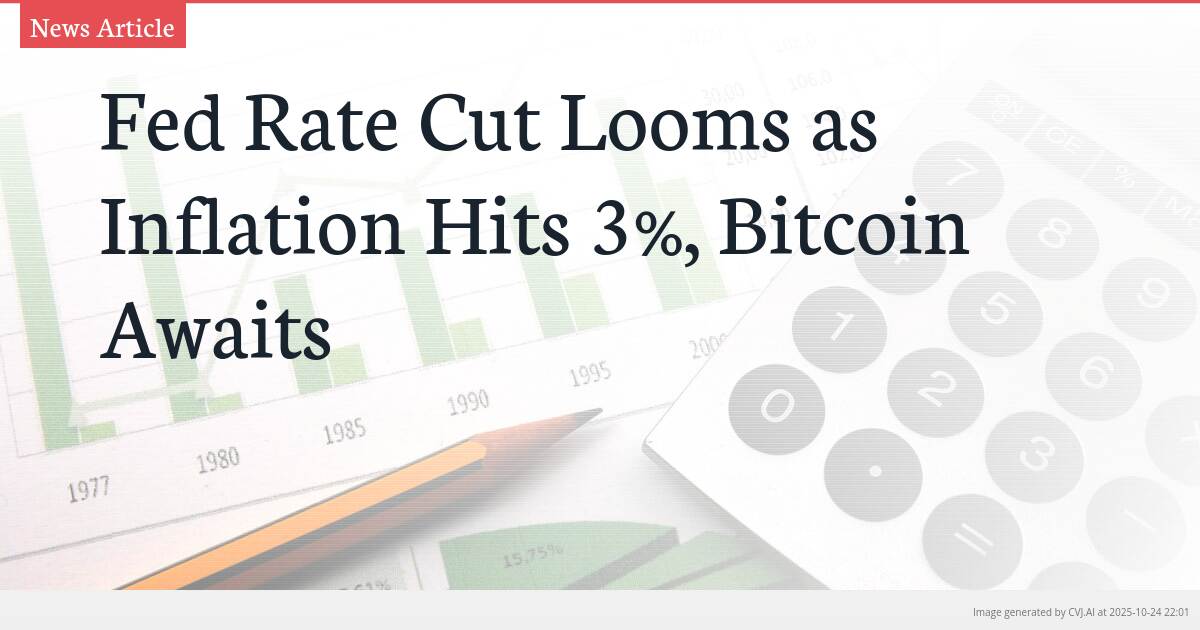This summary text is fully AI-generated and may therefore contain errors or be incomplete.
Introduction
Despite US inflation ticking up to 3.0% year-over-year in September, financial markets remain overwhelmingly confident the Federal Reserve will deliver a rate cut next week. Futures markets price a near-certain 25 basis point reduction, with the policy rate expected to glide toward approximately 3% by October 2026. This monetary policy trajectory carries significant implications for Bitcoin and digital assets, where transmission now occurs through both real yields and volatile ETF fund flows.
Key Points
- Futures markets price 90% probability of Fed rate cut next week despite 3% inflation reading
- Market expects policy rate to decline from current 3.75-4.00% to approximately 3% by October 2026
- Bitcoin's price action now heavily influenced by both real yields and crypto ETF flow dynamics
Inflation Data Meets Unshaken Rate Cut Expectations
The Bureau of Labor Statistics reported September headline CPI at 3.0% year-over-year and 0.3% month-over-month, while core CPI held steady at 3.0% annually and 0.2% monthly. The monthly increase was primarily driven by a 4.1% surge in gasoline prices, with shelter inflation remaining elevated near 3.6%. Despite this inflationary pressure, rates traders showed minimal reaction, maintaining their conviction that the Federal Reserve will proceed with monetary easing.
According to CME Group’s FedWatch tool, futures markets place the probability of a 25 basis point cut at the October 29 FOMC meeting above 90%. This would lower the target federal funds rate from the current 3.75%-4.00% range to 3.50%-3.75%. The market-implied path suggests further declines, with the center of the distribution pointing toward approximately 3% by this time next year, reflecting expectations for sustained monetary policy normalization.
The 2026 Policy Landscape: Three Potential Paths
Looking toward October 2026, FedWatch data reveals the highest probabilities for the federal funds rate cluster in the 2.75%-3.25% range, with a probability-weighted midpoint of about 2.97%. This aligns with Goldman Sachs’ projection of three cuts in 2025 and two more in 2026, landing the funds rate in the 3.00%-3.25% range by late 2026. However, the Federal Reserve Bank of Cleveland’s Simple Monetary Policy Rules dashboard suggests a more hawkish alternative, with median rules paths in the high-3s for 2026 if sticky inflation components persist.
The analysis outlines three distinct scenarios for the policy path through October 2026. The base case of ‘glide and grind disinflation’ envisions core inflation trending lower without labor market disruption, with policy rates settling near 2.75%-3.25%. A ‘sticky inflation’ path would see core inflation remaining near or above 3%, forcing the Fed to maintain a more guarded stance with rates stabilizing closer to 3.25%-3.75%. The ‘growth scare’ scenario would deliver front-loaded easing toward 2.25%-2.75% following economic deterioration.
The gap between futures-implied paths and rules-based estimates creates hawkish risk to the 3% endpoint if core disinflation stalls. This tension between market expectations and potential policy constraints forms the central uncertainty in the monetary policy outlook through 2026.
Market Transmission and Yield Curve Dynamics
The yield curve context reveals how potential easing might filter through financial conditions. Two-year Treasury yields have hovered in the mid-3.4% to 3.5% zone, while the 10-year remains near 4% and 30-year breakeven inflation sits close to 2.25%. A Reuters strategist poll indicates the long end may stay firm around 4.1%-4.2% over the next 6-12 months as term premium and fiscal supply limit declines.
This creates a scenario where the front end of the curve falls while the back end remains sticky, leading to curve steepening that would temper how ‘easy’ broad financial conditions become even with policy rate cuts. The Chicago Fed National Financial Conditions Index and 10-year TIPS yield remain crucial gauges for assessing the transmission of monetary policy to risk assets, including digital currencies.
Bitcoin's Dual Transmission Channel: Real Yields and ETF Flows
For digital assets, the link to monetary policy now runs through both real yields and fund flow dynamics. According to CoinShares data, global crypto ETPs experienced extreme volatility in early October, with record $5.95 billion weekly inflows as Bitcoin reached approximately $126,000, followed by $946 million in outflows the following week amid heightened volatility. These flow pulses coincided with over $19 billion in liquidations after former President Donald Trump announced new tariffs on China, altering macro projections.
Spot Bitcoin has since consolidated around $108,000-$111,000 ahead of the CPI release and FOMC decision. The ETF demand channel now represents a significant share of incremental buying, adding convexity to Bitcoin’s price response when financial conditions ease. Each of the three policy paths through 2026 carries distinct implications for Bitcoin: the base case is constructively bullish if real yields edge lower and ETF inflows persist; sticky inflation would likely keep Bitcoin range-bound with a firmer dollar and higher real rates; while a growth scare would initially trigger risk-off sentiment followed by liquidity-driven recovery.
Global central bank policies provide additional context, with the ECB pausing after its early-2025 cuts and the Bank of England easing more cautiously with UK inflation still above target. These cross-currents limit potential dollar depreciation and shape the environment in which Bitcoin’s macro beta to real yields plays out. The immediate catalyst remains next week’s FOMC decision, where a 25 basis point cut paired with cautious guidance could loosen the front end while the 10-year holds near 4%, creating the conditions for Bitcoin’s next significant move.
📎 Read the original article on cryptoslate.com

